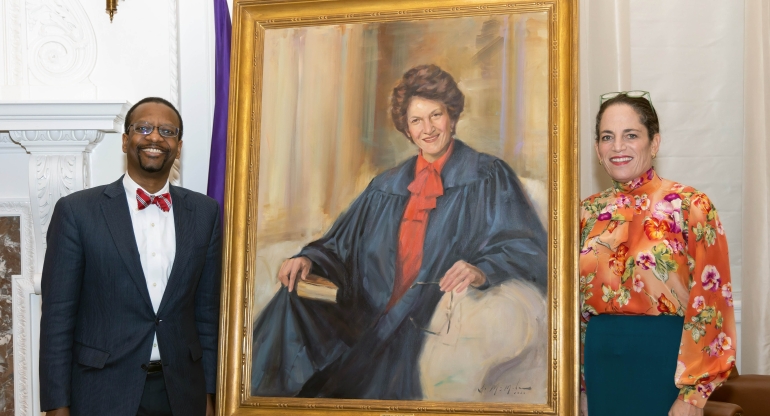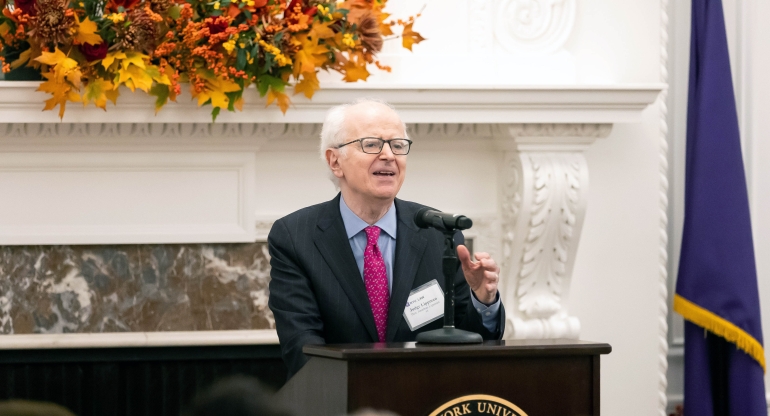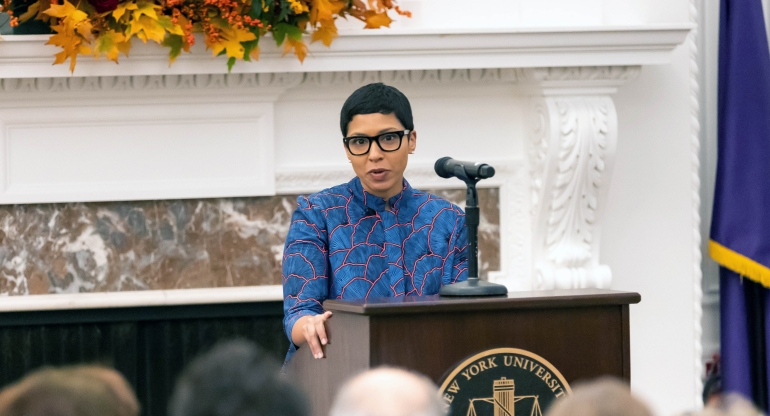NYU Law honors Judge Judith Kaye ’62 with a portrait unveiling
The late Judith Kaye ’62, a pioneering woman leader in the legal profession who made her mark as chief judge of the New York Court of Appeals, was honored by the NYU Law community on November 7 when her portrait was unveiled in Greenberg Lounge.
“To have a portrait of Chief Judge Judith Kaye here is quite meaningful,” said Dean Troy McKenzie ’00 in his welcoming remarks. “It signifies to all of us who inhabit these halls that her life and career were ones that we should all strive for. She defied many barriers to enter within the elite parts of the law and the judiciary.”
The child of immigrant parents, Kaye first worked as a journalist before attending NYU Law as an evening student. After working her way through law school as a copyeditor, she graduated sixth in her class—one of just 10 women in the Class of 1962. Hired by Sullivan & Cromwell, she later worked in IBM’s legal department; as a part-time assistant to the Law School’s dean while raising a family; and as the first woman partner at Olwine, Connelly, Chase, O’Donnell & Weyher.
But Kaye was best known for her remarkable quarter-century stint as a judge of the New York State Court of Appeals, which she joined in 1983. A decade later, she became the first woman to serve as New York’s chief judge. Kaye remained in that role for 15 years until her retirement in 2008, making her the longest-serving chief judge to date. She passed away in 2016.
While renowned for her well-crafted and game-changing opinions on issues such as the death penalty and LGBT rights, Kaye was equally committed to her administrative role as chief judge. In that capacity, she spearheaded a sweeping modernization of the jury system and established specialized courts focused on matters including drug abuse, domestic violence, and mental health.
During the unveiling, Jonathan Lippman ’68, Kaye’s successor as chief judge, called her “a chief judge in the tradition of John Jay, Benjamin Nathan Cardozo, all of the giants of New York jurisprudence. She was a little different than the others before her in that she wore red shoes.”
Lippman characterized Kaye as an early proponent of state constitutional rights as well as a consensus builder: “She really started the revolution in high courts around the country in recognizing that sometimes state constitutions have far better, stronger guarantees of rights than under the federal Constitution…. She also championed the idea that New York’s highest court should speak with one voice. In her mind, you strive for consensus above everything else, because it makes the law more clear for the public and for the bar…. Her view was that dissents were saved for matters of the highest principle…. And when those kinds of matters came before her, boy, did she rise to the occasion.”
Lippman quoted from Kaye’s most famous dissent, in Hernandez v. Robles (2006). In that case, Kaye argued that her colleagues in the majority, who ruled against granting same-sex couples the right to marry, were on the wrong side of history. Five years later, the state legislature made same-sex marriage legal in New York.
Also speaking at the ceremony, Frederick I. and Grace Stokes Professor of Law Melissa Murray underscored Kaye’s importance in the area of family law. In 1989, Kaye joined the majority opinion in Braschi v. Stahl Associates Co., in which the Court of Appeals ruled that a surviving same-sex partner qualified as “family” and was entitled to remain in the rent-controlled apartment where the couple had cohabitated.
“It seems a relatively small thing: the recognition as a family member for purposes of one city’s arcane rent-control regime,” said Murray. “But Braschi and its logic became the legal bedrock for same-sex couples seeking judicial recognition of their relationship and their rights. Well before Judge Kaye’s blistering dissent in Hernandez v. Robles, she, as part of the Braschi majority, laid a foundation for a more expansive and inclusive understanding of the family.”
Before helping McKenzie to unveil the portrait—painted by Memphis-based artist Jamie Lee McMahan—Luisa Hagemeier ’91, Kaye’s daughter, noted its placement among paintings of other NYU Law luminaries in Greenberg Lounge. Her mother, Hagemeier recalled, had skipped multiple elementary-school grades, making her feel like “sort of a weirdo” who never quite fit in until she came to NYU Law, where she found a home and inarguably thrived.
“It’s a cherished place for our entire family,” said Hagemeier of the Law School. “My mother is in the company she would have chosen tonight amongst all of you, and she will dwell now here amongst company that she would have chosen in Greenberg.”
Watch the video of the event:
Posted December 1, 2022




